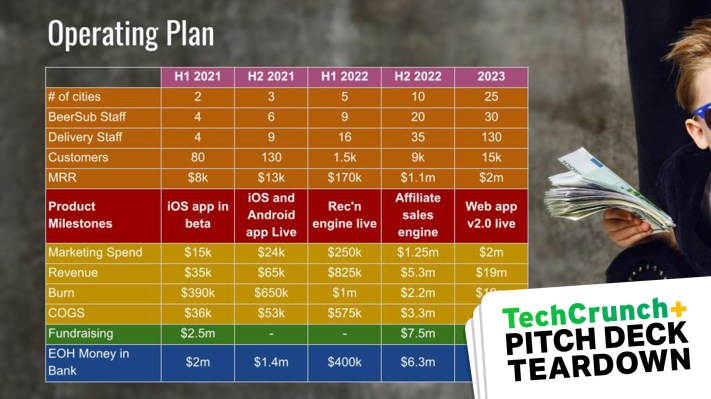
Over the course of the past 10 weeks, I’ve taken apart 10 pitch decks as part of our Pitch Deck Teardown series. All the decks had their own strengths and weaknesses, but there was one glaring omission from most of the decks I reviewed: an operating plan. Leaving it out of your deck might be forgivable if you have an appendix or a more detailed financial plan, but those tend to be too detailed. Here’s an overview of why you need one — and how to make one.
In short, an operating plan is a high-level numerical view of the near future of your company. It describes, in measurable terms, what you need to do to get from where you are now to where you need to be to raise your next round of funding. And it presents this information in a way that is easy to digest and discuss, without getting too bogged down in the nitty-gritty of the numbers.
Why you need to tell your story in numbers
When you’re raising funds for your company, chances are that you’re trying to convince a venture capital firm to give you money. On Twitter, VCs love to paint themselves as the cool kids on the block, but don’t listen to ’em. Venture capitalists work in the financial services industry like the rest of the bankers and capitalists, which means they are beholden to their own investors. Fiduciary responsibility is a crucial aspect of venture capital; they’ll never raise another fund unless they understand the financial machinations that go on under the hood in their own firm, their fund, and the startups they invest in. All of this is to say: Money is the alpha and the omega of venture capital, and to be successful in raising money, you need to be able to speak that language.
When you weave a compelling narrative in numbers, you’re talking the language of venture capital. Numbers are king. Haje Jan Kamps
When you are raising money, you’re in essence painting a picture for your investors: If you give me X dollars, I will move my company from where it is today to a position where it is worth a lot more money. To do that, I will change certain aspects of my company. Those aspects might be staffing (you’ll hire more folks to build a better product), it may be product (if we build features A, B, and C, we can sell this product), or it may be building traction (we are going to go from 2,000 paying users to 25,000).
None of this should be new to you; as a founder, this is the bread and butter of your job. Your operating plan, then, is how you tell your story, not in words, but in numbers. That’s crucial. When you weave a compelling narrative in numbers, you’re talking the language of venture capital. Numbers are king.
So let’s discuss what needs to go into your operating plan, how to present it, and how to check for inconsistencies in the plan.




![Read more about the article [Funding alert] StanPlus raises $20M in Series A round led by HealthQuad, Kalaari Capital, and HealthX Capital](https://blog.digitalsevaa.com/wp-content/uploads/2022/01/Stanplus-news-1642943573589-300x150.jpeg)



